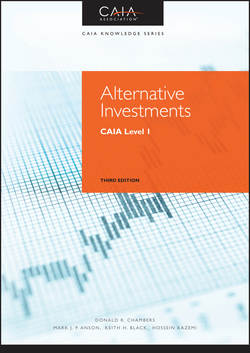Читать книгу Alternative Investments - Hossein Kazemi - Страница 44
На сайте Литреса книга снята с продажи.
PART One
Introduction to Alternative Investments
CHAPTER 3
Quantitative Foundations
3.4 Problems with Internal Rate of Return
3.4.1 Complex Cash Flow Patterns
ОглавлениеFor the purposes of this analysis of IRRs, a complex cash flow pattern is an investment involving either borrowing or multiple sign changes. A borrowing type cash flow pattern begins with one or more cash inflows and is followed only by cash outflows. An example of the borrowing pattern is when an investment such as a real estate project is sold and leased back. The divestment generates current cash at the cost of future cash outflows and may be viewed as a form of borrowing. A multiple sign change cash flow pattern is an investment where the cash flows switch over time from inflows to outflows, or from outflows to inflows, more than once. An example of a multiple sign change investment would be a natural resource investment involving (1) negative initial cash flows from purchasing equipment and land to set up an operation such as mining, (2) positive interim cash flows from operations, and (3) negative terminal cash flows from ceasing operation and restoration expenses. Exhibit 3.2 illustrates the complex cash flow patterns.
Exhibit 3.2 Complex Cash Flow Pattern Examples
In the case of borrowing type cash flow patterns, there is a unique solution (i.e., there is only one IRR that solves the equation), but the IRR must be interpreted differently. In borrowing type cash flow patterns, a high IRR is undesirable because the IRR is revealing the cost of borrowing rather than the return on investment. Also, when a trial-and-error search is performed to find the IRR, any increase in the discount rate lowers the present value of the cash outflows rather than lowering the present value of the cash inflows, as would be the case in a simple cash flow pattern. Thus, the trial-and-error process must operate in a reverse direction from the simplified investment cash flow pattern. In other words, if the net value with a given discount rate is positive, the next IRR in the search should be lower rather than higher, as occurs in the case of a simplified cash flow pattern.
In the case of multiple sign change cash flow patterns, the problems are more troublesome. Whenever there is more than one sign change in the cash flow stream, more than one IRR may exist. In other words, two or more answers can probably be found using the IRR formula. In fact, the maximum number of possible IRRs is equal to the number of sign changes. When more than one IRR is calculated, none of the IRRs should be used. There is no easy way for the IRR model to overcome this particular shortcoming.
Consider a derivative deal that ends poorly for Investor A. The derivative required a $5,000 outlay from Investor A to the counterparty to open. In the first period, the derivative generates an $11,500 cash inflow to Investor A from the derivative's counterparty. The derivative then generates a cash outflow of $6,550 from Investor A at the end of the second period, at which point the derivative terminates. The derivative's cash flows from the perspective of Investor A are given in Exhibit 3.3, assigning period 0 to the first nonzero cash flow.
Exhibit 3.3 Cash Flows of Hypothetical Derivative Contract
This cash flow pattern changes signs twice, once from negative to positive and once from positive to negative. There are two IRRs: 3.82 % and 26.20 %. Both 3.82 % and 26.20 % satisfy the definition of the IRR because they set the present value of all cash inflows equal to the present value of all cash outflows. The net value of the present values of the cash inflows and outflows is illustrated in Exhibit 3.4. Note that the line crosses the horizontal axis twice, defining two different IRRs.
Exhibit 3.4 An Example of Multiple IRRs
With the two IRR solutions 3.82 % and 26.20 %, there may be a temptation to think that the two IRRs can be somehow analyzed in unison to generate an intuitive feel for the derivative's attractiveness. But neither number is particularly useful, because the investment is really a combination of investing from period 0 to period 1 and borrowing from period 1 to period 2. In this particular case, the cash flow patterns have a positive net value between the two IRRs, using discount rates between 3.82 % and 26.20 %. But as a derivative, it is obvious that the cash flows to the other side of the derivative (the counterparty) would have the same numbers, but the signs of the cash flows would be reversed. In this case, the cash flows would be +$5,000, –$11,500, and +$6,550. From the counterparty's perspective, the IRR solutions would still be exactly the same at 3.82 % and 26.20 %. However, the deal's graph would appear as a mirror image, with negative net values between the two IRRs. As we would expect with a derivative deal, gains to one side of the contract would equal losses to the other side of the contract. Both sides would view the same IRRs because they used the same cash flows, but they would be looking at opposite cash flows and opposite net values. Therefore, using only the IRRs to decide if the derivative is beneficial is not possible.
